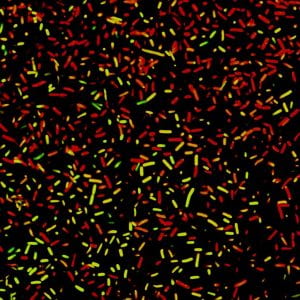Phages have been considered for antibacterial therapy ever since they were discovered in the early 20th century. However, significant concerns about their self-replicating, evolving nature have been difficult to avoid. For example, phages can spread antibiotic resistance or toxin genes, and exponential amplification leads to unpredictability – not desirable for a therapy. To rein in the phages, we developed a two-part strategy. We use a well-known phage as the basis for genetic engineering to modify its host tropism. Then, this chimeric phage is chemically modified to attach to nanoscale gold rods, which have the interesting property of converting light to heat. The heat kills both the phages and the bacteria they attach to, creating a version of phage therapy that is controllable by light.
Postdoctoral fellow Huan Peng brought his expertise in materials chemistry to this project and taught us all about gold nanorods. We look forward to exploring these hybrid materials further!
Peng H, Borg RE, Dow LP, Pruitt BL, Chen IA. Controlled phage therapy by photothermal ablation of specific bacterial species using gold nanorods targeted by chimeric phages. Proc. Natl. Acad. Sci USA, DOI: 10.1073/pnas.1913234117.

